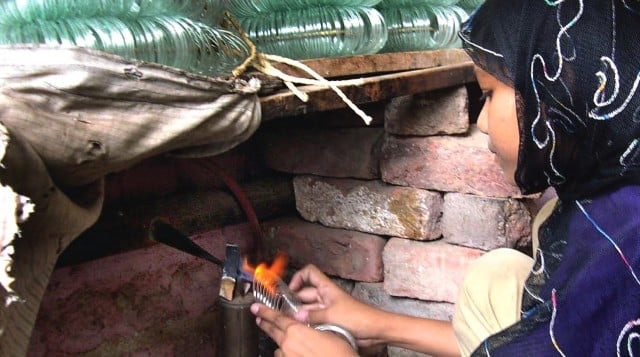All that tinkles is not gold

Hyderabad, the largest producer of glass bangles, is known for its colourful trade. Bangles made here are sent all over Pakistan and even exported.
However, while the bangles might be pretty to buy, the process behind them can be less than perfect. According to the workers, the wages are low in the initial stages of bangle-making while the work is strenuous and intricate.
Samina, a home-based worker, said that she works for 10 to 12 hours every day but receives a nominal wage for her labour.
“I get Rs5 for juraai per toora,’ she said, “Every month we have to pay utility bills. We don’t earn as much as we have to spend and we have to work in a hot and uncomfortable environment.”
Samina feels that her hard work deserves a better pay. She’s not alone in her demand as thousands of others have complained of similar problems. Many of the women working in this industry are illiterate and several of them are underage. According to officials, girls as young as seven are working in precarious conditions. There are no dispensaries nor schools for the 30,000 children of these workers.
Meanwhile, producers in the district boast that the bangles they make are unique and varied, with people getting the kind of variety that is not available elsewhere. The prices, like the types, also vary with some as cheap as Rs25 a set. The expensive ones can cost up to Rs500.
Making of bangles
Bangle making is an extensive process, beginning with glass spirals that are constructed in factories. These raw bangles are then handed over to contractors who supply them to home-based workers for further processing. The third stage is colouring, which is followed by designing. Finally, shopkeepers are handed over the bangles and from there they slip into the wrists of young girls and old women across the province and country.
According to a study by the Collective for Social Science Research, most of these stages involve application of intense heat to glass in order to melt, shape, reshape and join the bangles. Different sources of heat, including furnaces, ovens and small burners, are used in these diverse processes. Other processes also include making bundles of finished bangles and applying chemicals for cleaning and polishing the bangles.
The process looks very easy but is actually very long and complicated and it takes a lot of hard work at each stage, said workers. Suhail Ahmed, a bangle designer, said that he receives plain bangles that are measured in toora. A single toora contains 24 dozen bangles and all monetary calculations are based on toora.
Wages of makers
According to Ahmed, workers get Rs50 per toora for designing. A single worker can design around 3 to 4 tooras every day. Designers get good salaries but those involved in the second stages of Jurrai and Saddai earn very little, said the designer.
A ready-to-wear toora costs Rs100 and it is sold to the wholesaler for Rs115. The wholesaler then sells it to retailers for Rs120 to 125. The last in the chain, which are the customers, buy these bangles for around Rs200 per toora.
Published in The Express Tribune, June 28th, 2010.



1724319076-0/Untitled-design-(5)1724319076-0-208x130.webp)















COMMENTS
Comments are moderated and generally will be posted if they are on-topic and not abusive.
For more information, please see our Comments FAQ